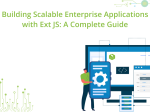The Future of React Framework: Trends to Watch in 2025 and Beyond
Right now, in 2025, React’s still the first pick for a lot of developers working on the frontend. If you’re just building a clean, simple interface or diving into something way more detailed, React’s got your back. It’s easy to use, grows with your project, and just makes things smoother. That’s pretty much why folks keep going back to it, whether it’s a small site or a big app, it works.

More teams are now exploring the best React UI framework options to speed up development and keep interfaces smooth. It’s not just about building components; it’s more about building fast and scalable modern web applications.
These days, it’s used for building mobile and even desktop apps too. Now, you can definitely build a React app without using any extra tools or frameworks.
Looking ahead, the React application structure is evolving fast. So right now, things like server components, low-code tools, and AI features are starting to shape how we build apps. You’ll also see more use of Java React framework setups and handy tools like React app builders.
In this post, we’ll check out what’s trending, including examples like Next.js and Gatsby, and see where React is going next.
The Evolution of React Frameworks
Since being launched by Facebook in 2013, React has advanced significantly. One of the most widely used tools in contemporary web development began as a basic JavaScript library for creating user interfaces. React’s more than just putting components together. It’s more about building apps that load fast, can grow as the needs change, and are easy to use.
Initially, developers mostly used the basic React library. They used to mix in tools like Redux for state and React Router for navigation. It worked fine at first, but as apps grew, things got tricky. Server-side rendering wasn’t smooth, and SEO took a hit. Developers started to feel the mess and wanted a cleaner setup. That’s pretty much when modern React frameworks started popping up to make things easier and more organised.
Next.js changed the way people built web apps. It made things simpler for developers and brought in features like server-side rendering and dynamic routing. Not long after, Gatsby showed up and made it easy to create super-fast static websites. Both tools helped push the React world forward, showing how much it’s grown with tools that are actually fun to use.
Now, there’s no shortage of choices. You’ve got Remix, React Native, Reext and other tools built around the React frontend framework. Whether you’re building a small blog or a complex dashboard, there’s a React application builder or UI solution that fits the job.
One thing that makes the React JS framework really useful is how it’s built around components. You can reuse the same pieces of UI in different parts of your project, which honestly saves a ton of time. Plus, with all the design systems out there now, teams get better control over how their apps actually look and feel.
If you want to learn learn React framework or are wondering how to build a React app without using a full framework, there’s a lot out there to help. And when it comes to making real apps, the best React UI framework choices keep improving to fit what today’s developers actually need.
Building a React JS app these days is a lot smoother than it used to be. You can go from sketching out your idea to having a live React web app without too much hassle. The setup’s pretty simple to get the hang of, and the tools make things smoother. React works well whether you’re building something solo or teaming up with others.
Key Trends Shaping React Frameworks in 2025
React is changing quickly. If you’re working with the React framework or just learning it, staying updated really helps. New tools pop up often and can make your projects quicker and easier to handle. So yeah, here’s a quick look at what’s moving React forward in 2025.
Edge Computing is Speeding Things Up
Edge computing is changing how we think about speed in web development. Edge computing moves data and tasks closer to where you are, not back to a main server. So apps respond faster and things run more smoothly without all the back-and-forth delays.
When used with a React web application, this setup drastically cuts down delays. Many of the most popular React frameworks are starting to support edge deployments. As modern business applications go global, the React frontend framework is becoming a natural fit for low-latency, real-time environments.
Whether you’re working with a basic UI framework for React or a full-blown enterprise project, edge support is becoming a must-have.
AI is Now Your Coding Sidekick
AI tools keep getting better. They can finish your code, spot bugs, and even clean things up. By 2025, they’re not just extras anymore – they’re part of the way we build software now, like another helpful set of hands.
If you’re starting a new React application, you’ll probably use an AI-based IDE to help write cleaner components and organise things better. It really makes the whole React JS application development process smoother. Even the tricky parts feel easier when AI gives you a hand with structure and flow.
You don’t have to be an expert to benefit from these tools—they’re becoming accessible for everyone trying to create React JS applications with better performance and fewer errors.
Developer Experience Keeps Getting Better
React has always aimed for a clean developer experience, and now it’s getting even more refined. Tools like Next.js, ReExt, and other top UI frameworks for React are focusing on real-time collaboration, smarter debugging, and improved documentation.
If you’re looking into React framework examples or starting a new React application, this is actually pretty helpful. Hot reloading, easy navigation, and clear visual feedback are all built in now – it just makes the whole process easier to manage.
For teams, this also improves how you manage large codebases with ease using the best React UI framework that suits your project goals.
Low-Code Meets React Power
Low-code platforms are on the rise, and they’re starting to integrate with the JavaScript grid framework and other powerful UI tools. In 2025, more tools will quietly use React UI frameworks, letting folks build apps with little to no coding.
If you’ve wanted to make a React app without all the setup or long code, these simple low-code platforms help you do just that – clean results, less effort. For developers, this opens up faster prototyping and easy collaboration with business teams. It’s also a smart move for those working in business software management or building custom business software systems.
React’s still the top pick for building modern apps, whether you’re a solo developer or part of a big team. It works great for small projects and large enterprise tools. You can write the code by hand or use a builder. Both options help keep things quick, flexible, and easy to manage, and developer-friendly.
The Rise of Alternative React Frameworks
React is still a top choice for front-end work, but more tools are popping up around it. They’re not replacing React – just helping you do more with it, kind of like giving your favourite tool a few extra tricks. Some tools make things easier with better setups and helpful features. If you’re starting to learn the React framework or want to build apps in a cleaner way, there are a few options that really stand out and are worth checking.
ReExt
ReExt blends Ext JS with React to create a hybrid framework aimed at enterprise needs. You use JavaScript to write the components, and they show up like actual native elements on both Android and iOS. If you’ve already worked with the React frontend framework, this makes jumping into mobile a whole lot easier since you don’t need to start over with a brand-new language. For those who want a reliable React application builder, this tool is worth a serious look.
Next.js
If you’re building with React and want stuff like server-side rendering or static pages, Next.js really makes things easier. Routing just works without setup, and handling APIs feels less messy. It even plays nice with TypeScript. It actually boosts your SEO, too, which is pretty helpful. If you’re working on something a bit more involved, going with Next.js can really cut down the time and effort you’d spend fixing things later.
React Native
React Native brings the React model into mobile development. You build components with JavaScript, and they show up as native widgets on Android and iOS. It’s a pretty smooth way in if you’re already comfortable with the React frontend framework and want to get into mobile without picking up an entirely new language. It fits perfectly if you’re building cross-platform apps as part of your broader React js application development strategy.
Gatsby
Gatsby’s pretty solid if you’re working on something like a blog, a portfolio, or maybe a docs site. It builds everything ahead of time, so pages load super fast, which search engines love. You can also plug in a CMS, so content updates don’t need a developer every time. If you’re after speed and simplicity in a React setup, Gatsby’s one of those tools that just makes sense.
Sometimes you feel like starting a React JS app from scratch. Other times, it’s just easier to pick a framework that handles the hard parts. Either way, these tools give you a solid base. It really shows how React keeps evolving to match what developers actually want right now.
Challenges & Considerations
As powerful as React is, no tool is perfect. There are a few challenges that React developers may face in 2025:
Performance vs. Complexity: Trying to make your app faster with things like memoisation, lazy loading, or suspense? It can help with performance, no doubt. But here’s the thing – it also makes your code a bit harder to read and manage. So, it’s kind of a trade-off between speed and keeping things simple.
Choosing the Right Stack: React by itself might not cover everything. Sometimes you might go with Next.js, Gatsby, or even build your own setup – it just depends on your project and how much control you need.
Frequent Updates: React evolves quickly. While updates bring improvements, they can break existing components.
A lot of developers are now trying out ways to build a React application without using any full-on framework. While this gives full control, it lacks the advanced features that modern frameworks offer.
Where React Frameworks Are Heading Beyond 2025
Looking beyond 2025, it’s pretty clear that React frameworks will keep growing and changing to match the way the web is moving forward.
WebAssembly Integration
WebAssembly is catching on lately. It lets you run stuff written in languages like C++ or Rust right in your browser, which is pretty cool. This opens the door for super-fast data processing in React web applications.
Imagine running AI models or video processing directly in your React application without server latency. Wasm + React = high-performance, next-gen apps.
React Server Components (RSC)
React Server Components are a major shift in how we render content. They allow parts of your app to be server-rendered while others remain client-side.
This hybrid rendering model reduces JavaScript bundle sizes, making apps faster and more scalable. It’s ideal for complex React application structures where performance and interactivity both matter.
Conclusion
React isn’t just a tool for building interfaces anymore – it’s really become the go-to base for front-end work. Whether you’re just starting out or handling big apps with tools like ReExt, there’s room to grow. It continues to develop, and to be honest, building with it is always fun.
From server-side rendering and AI-powered tools to edge computing and low-code innovation, the React ecosystem keeps growing. Even if you want to create a React app without framework extras, there’s still a lot that makes React application development smooth and flexible.
If you’re thinking about learning React, now’s a pretty good time. Try starting with the fundamentals and then looking at tools like Next.js, Gatsby, or even ReExt. There is probably a system out there that will work well for you, regardless of how big or small your project is.
FAQ
What component framework is good for React?
Next.js, ReExt, and Gatsby are great picks for building with React. Each one stands out in its own way – like handling server-side rendering, making static sites, or offering strong UI tools for big apps.
Is React a framework or a library?
React’s just a library for building interfaces, yeah. But once you add tools like Next.js or ReExt, it kind of turns into a full-on framework experience.
Is React JS a framework?
React JS is technically a library, but most folks call it a framework because it does so much and fits into all kinds of app setups.
How to run a React application?
Once you’ve made your project with something like Create React App or Next.js, just run npm start or yarn start, and your React app will launch.
What is a React application?
A React application is a web or mobile app built using the React UI framework. It uses components to create interactive user interfaces.
How to create a React application?
You can create a React application using Create React App, Next.js, or other scaffolding tools. Run npx create-react-app my-app to get started quickly.
What is a React application used for?
React applications are used to build fast, interactive, and scalable user interfaces, ranging from single-page web apps to complex enterprise dashboards and mobile apps.
Try ReExt today and experience the power of seamless, high-performance, full-stack solutions!

The modern enterprise ecosystem thrives on agility, scalability, and digital innovation. In today’s competitive market…

In today’s hyper-digital economy, enterprises no longer compete merely on products – they compete on…

Enterprise software has never been under greater pressure. Digital-first users expect consumer-grade experiences; stakeholders demand…









